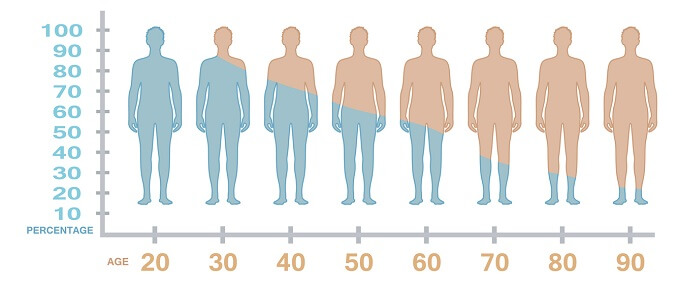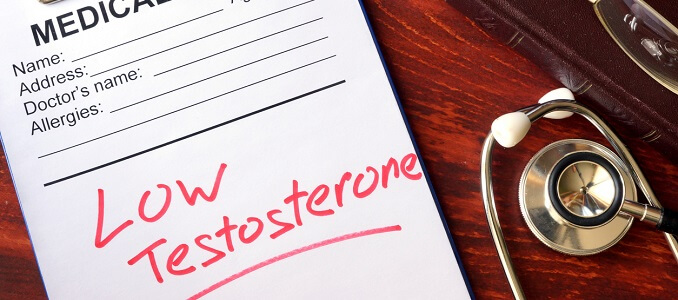Average Testosterone Levels by Age
Looking at a chart of average testosterone levels by age may not tell the whole story of low testosterone.
The normal testosterone level for men and women does change with age. Healthcare professionals do use a chart that tells them the average normal testosterone level for a given age or gender. However, just looking at the normal levels of testosterone on the chart is often not enough to make an accurate diagnosis of low testosterone.
This is because everyone’s body reacts to their individual level of testosterone differently. Two people of the same age with the exact same level of testosterone could be feeling very differently. What may cause one person to have symptoms of low testosterone could have the other feeling just fine.
Testosterone is a critical hormone for both men and women. While testosterone is the primary male hormone or androgen, women’s bodies make and need testosterone, too, albeit to a less degree. In men, testosterone is responsible for all of the characteristics we relate to maleness – i.e., facial hair, bigger muscles, deeper voice, etc. In both sexes, testosterone plays a vital role in sexual health, fat metabolism, bone health, cognition, and much more.
Testosterone levels do decline as we age, which can lead to several health issues associated with low testosterone.
Testosterone Levels in Men
Testosterone production in men starts as early as in the womb. We are all born “female” it is the release of testosterone in a developing fetus with male chromosomes that begins its differentiation into a male. From birth through adolescence, testosterone levels in boys continue to increase. In adolescence, a large surge of testosterone is responsible for the characteristics of “manhood” – development of the sex organs and secondary sexual characteristics such as beard growth, deepening voice, etc.
Testosterone levels in men then peak at around the age of 20. After that, they start a steady decline.
The chart below breaks down the average testosterone levels in men by age:
|
AGE YEARS |
AVERAGE FREE TESTOSTERONE pg/mL |
AVERAGE TOTAL TESTOSTERONE ng/dL |
NORMAL TOTAL TESTOSTERONE ng/dL |
|
30 – 40 |
8.7 to 25.1 |
219 to 1009 |
600 to 675 |
|
40 – 50 |
6.8 to 21.5 |
201 to 993 |
500 to 550 |
|
50 – 60 |
7.2 to 24.0 |
170 to 918 |
400 to 450 |
|
60 + |
6.6 to 18.1 |
156 to 700 |
300 to 350 |
As you can see, the average testosterone levels in men by age can vary quite a bit. For example, if we take a look at a 45-year-old man, his average testosterone level range can go from 201 ng/dL all the way up to 993 ng/dL. What is considered to be normal is between 500 ng/dL and 550 ng/dL. That leaves everyone at the lower end with a possible concern. This is why doctors and clinics that provide testosterone replacement therapy aim for an “optimal” testosterone level, not necessarily “normal” on the charts. Our doctors aim for the 550 mark when providing testosterone replacement therapy to men as the ideal average testosterone level.
What Are Considered Low Testosterone Levels?
As we have discussed thus far, you can see that the “normal” or healthy level of testosterone in the blood can vary greatly from person to person. According to the most recent guidelines from the American Urological Association (AUA), for a man, a testosterone level of at least 270 nanograms per deciliter (ng/dL) is considered the average normal. Any man with a testosterone level below 270 ng/dL could be diagnosed with low testosterone or hypogonadism.
What Are Considered Normal or Average Testosterone Levels?
The guidelines for average or normal testosterone levels in men is currently a range between 270 – 1070 ng/dL. Why does the lowest point of that range – 270 ng/dL – differ from the 219 ng/dL shown in the chart on this page? Different labs have different values for what they consider the average or normal ranges and what constitutes low testosterone. That is why doctors like ours who specialize in testosterone replacement therapy look at more than blood test results and consider your symptoms, medical history, lifestyle, and overall fitness goals before recommending low testosterone treatment.
What Are Considered High Testosterone Levels?
Though it is far less common, too much testosterone can also be a problem. Excess testosterone in men can lead to more aggressive and irritable behavior, more acne and oily skin, sleep apnea, and an unwanted increase in muscle mass. Too much testosterone can also lead to lower sperm counts, infertility, and shrunken testicles. Depending on your age, medical history, and physical condition, if you are male, your doctor may consider your testosterone levels too high if your testosterone level is above 950 ng/dL.
Testosterone Levels in Women
Women’s bodies make and need testosterone as well. Obviously, men produce a lot more testosterone than women. According to Mayo Clinic Laboratories, for women ages 19 and up, normal testosterone levels range from 8 to 60 ng/dL.
Like men, women’s testosterone levels also decrease with age. However, unlike men who start to lose testosterone gradually over time, a woman’s testosterone plunges more “all at once” when she enters menopause.
What Determines Your Testosterone Levels?
Your testosterone levels are largely determined by four things:
- Your age
- Your gender
- Genetics
- Any existing medical conditions
As we have said, in men, testosterone levels peak around the age of 20. late and then start a decline by about 1% to 2% per year thereafter. Medical research supports these anecdotal observations. One such study found testosterone levels peaked at age 19.
Why Do Testosterone Levels Decline?
In men, testosterone is produced by the testes. An area of the brain stimulates the release of testosterone. A testosterone deficiency, low testosterone, or hypogonadism are defined as conditions in which a man’s body does not produce enough testosterone.
Testosterone deficiencies can be either primary – meaning that the problem is in the testes, or secondary, meaning that the decline in testosterone is being caused by a problem in the areas of the brain that signal the sex organs to make or release testosterone.
A recent study found that the decline in testosterone that largely begins after the age of 35 can cause both primary and secondary hypogonadism. The study concluded,
After the age of 35, testosterone levels start a gradual decline, averaging just over 1% a year. This drop may not matter much at first, but once a man is over 65, his average testosterone production is 30% below its peak. This is due to the slow depletion of both the hormones produced by the brain that stimulate testosterone production as well as actual production and release of testosterone by the testes.
In other words, aging in males leads to both “primary” and “secondary” testosterone deficiency.
Causes of Low Testosterone
There can be several causes of low testosterone. There are certain diseases and genetic conditions that can lead to low testosterone. Conditions that can cause low testosterone include:
- Obesity
- Diabetes
- Liver or kidney disease
- Other hormonal conditions.
However, the most common cause of low testosterone is simply getting older. In men over 30, typically, testosterone levels will drop by about 1% per year. By the time a man is in his 70s, his testosterone level could be half of what it was in his 20s.
Women lose a significant amount of testosterone once they reach the menopausal years.
Symptoms of Low Testosterone
Age-related low testosterone has many symptoms that impact your quality of life, including:
- Low libido, problems getting and keeping erections in men, vaginal dryness, and painful intercourse in women.
- Disturbed, disrupted sleep, or insomnia.
- Weight gain and increased body fat.
- Loss of lean muscle and decreased strength
- Decreased bone density.
- Swollen or tender breasts (women).
- Hot flushes and night sweats (women).
- Thinning hair.
- Decreased energy, low stamina, and low vitality.
- Lack of motivation or self-confidence.
- Mood swings, depression, and anxiety.
- Difficulty concentrating on cognitive tasks and memory loss.
How Do Doctors Test for Low Testosterone?
Low testosterone is diagnosed by measuring the amount of testosterone in the blood with a blood test. Testosterone travels in your blood as both “free” and “bound.” Bound testosterone is testosterone that is bound to proteins in the blood. Free testosterone is freely available in the bloodstream and available to your cells. Usually, you’ll get a total testosterone test, which tests for both. To diagnose certain conditions, doctors sometimes will look only at free testosterone levels. A measure of your total testosterone level is usually enough to provide a diagnosis of low testosterone.
The average testosterone levels by age mentioned on this page are total testosterone levels.
What to Do If You Have Low Testosterone
If you have low testosterone per your testosterone test and as indicated by your symptoms, you may be able to increase your testosterone levels by making some lifestyle changes. Things that could increase your testosterone include:
- Getting more sleep.
- Eating a heart-healthy diet.
- Reducing your consumption of alcohol.
- Quitting smoking.
- Losing weight and getting more exercise.
However, if you have been diagnosed with low testosterone or age-related testosterone deficiency, the only real way to treat it is with testosterone replacement therapy.
How Is Low Testosterone Treated?
Low testosterone is treated with testosterone replacement therapy. Testosterone replacement therapy is only available with a doctor’s prescription. Testosterone replacement therapy is available in several forms. Our doctors have found that intramuscular testosterone injections are the safest and most effective form of testosterone therapy.
Testosterone injections us small needles, are easy to give and are relatively painless. The many benefits of testosterone replacement injections include:
- Improve sexual function and more satisfying sex.
- Loss of fat.
- Increased bone density and protection against osteoporosis
- Improved mood and sense of well-being.
- Improved mental sharpness.
- Greater muscle strength and physical performance.
Now that you know a lot more about average testosterone levels by age, why not take a minute to contact us and learn more about how hormone replacement therapy can improve your quality of life?
- MedicalNewsToday
- Harvard Medical School
- Feldman HA, Longcope C, Derby CA, et al. Age trends in the level of serum testosterone and other hormones in middle-aged men: longitudinal results from the Massachusetts male aging study. J Clin Endocrinol Metab 2002;87(2):589-98.
- ack G, Zeitlin SI. The role of routine serum testosterone testing: routine hormone analysis is not indicated as an initial screening test in the evaluation of erectile dysfunction. Rev Urol 2004;6(4):203-6.
- Brambilla DJ, O’Donnell AB, Matsumoto AM, McKinlay J. Intraindividual variation in levels of serum testosterone and other reproductive and adrenal hormones in men. Clin Endocrinol (Oxf) 2007;67(6):853-62.
- Men`sHealth






